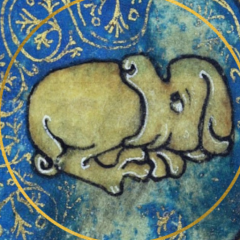
The year 2015 marks the 500th anniversary of the death of the great printer and publisher Aldus Manutius (c. 1449-1515), an Italian humanist scholar who founded the Aldine Press at Venice in 1494. His publishing legacy includes scholarly editions of classical authors, the introduction of italic type, and the development of books in small formats that were read much like modern paperbacks.
Aldus Manutius was a scholar, grammarian and teacher known in the most important humanist circles of the time before coming to Venice around 1490. In 1494 he established the Aldine Press during a time which came to be known as the Venetian High Renaissance. Early attempts to set Greek type had proved difficult, and demand for printed books in Greek was low. While Aldus was not the first to print Greek books, he certainly was the first to do so on a large scale and is credited with re-introducing original Greek texts to the western world after centuries of unavailability. Most of the principal classical Greek authors were first set in type by the Aldine Press. The texts themselves were edited by a large group of scholars, many of Cretan origin. Aldus formed a club of Greek scholars, called the Neakademia (the New Academy) inspired by the revival of Greek learning in Italy that followed the fall of Constantinople in 1453.
An innovative and progressive printer, Aldus is also credited with the creation of italic type which allowed him to introduce books in a small, compact format, known as libri portatiles. The italic font was designed to mimic scholars’ handwriting and to make the text more readable. His initiative to publish humanist texts in portable, octavo editions, which were inexpensive to purchase and easy to carry had a great influence on the democratisation of book ownership and the dissemination of ideas. This also embodied “the renaissance belief that antiquity provided models to be imitated in all activities”. Manutius stated many times that his goal was to make available in print the classic texts of the ancient world which were beloved by Renaissance humanists. The Aldine Press became a gathering place for many of the great thinkers of the day and Erasmus referred to this print shop salon as a university without walls.

The printer’s device of the dolphin and anchor is indelibly associated with the name of Aldus Manutius. This hallmark of the Aldine Press is arguably the best-known printer’s device in the history of printing. They serve to illustrate the iconographic representation of the Renaissance motto, ‘festina lente’, a paradox that means “make haste slowly”; the dolphin symbolising the former, and the anchor, the latter. The meaning evokes the idea that all activities should be performed with a proper balance of intensity and contemplation which is also reflective of the detailed yet constant output of the Aldine Press.
After Aldus’ death the press was run by two further generations of his family until 1598; Paolo Manuzio, his son, and Aldo the Younger, his grandson. Both were distinguished scholars and teachers as well as printers. Manutius and his grandson Aldo are also credited with introducing a standardised system of punctuation including developing the modern use of the semicolon and the appearance of the comma.
Liverpool Hope University is fortunate enough to have 10 ‘Aldines’ in the Radcliffe and Gradwell Collections, a few of which are currently on display outside the Special Collections Reading Room in The Sheppard-Worlock Library. There are a number of activities taking place worldwide to commemorate the 500th anniversary, including a free exhibition in the Sir John Ritblat Treasures Gallery at the British Library, entitled ‘Collecting the Renaissance: the Aldine Press 1494-1598’. The exhibition ‘Merchants of Print: Venice to Manchester’ will be on at the John Rylands Library, Manchester from 29th January to 21st June 2015. Aldine Press volumes, easily recognisable from their dolphin-and-anchor emblems have been sought after by many eminent collectors through the centuries. The exhibition at the British Library makes reference to a comment made in 1811 that “all the Aldine Classics produced such an electricity of sensation, that buyers stuck at nothing to embrace them!” and they continue to create a ripple of anticipation in the book world today.
